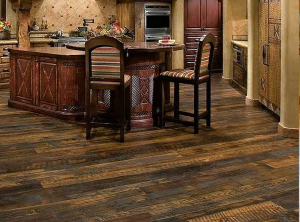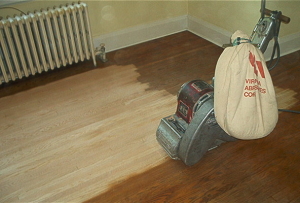The most important thing you can do is ask for references and then go look at the floors the contractor has installed, or finished. Installing and finishing wood floors is a skill and an art that is different for every person.
Also, be sure that the contractor you are considering is familiar and experienced in the type of flooring and finish you want. In fact, you may want to use the products the contractor is most comfortable working with — just because he is good at using one product, this does not mean he would be as good with every product.
You can ask what training they have had—those who have attended one of the NOFMA Installation Schools, or NWFA seminars, at least has taken the time to invest in their profession. But even so, make sure you actually look at their work.
The best way to clean a hardwood floor is to keep the dirt and grit off! This means putting walk-off mats at all exterior doors, and using floor protectors on chair legs. When you leave dirt and grit on your floors, you are just grinding the finish away. Remember to vacuum and dust mop regularly, and as often as necessary.
Be sure to follow the finish manufacturer’s advice on your floor. As a rule, do not use ammonia-based cleaners, they tend to dull modern finishes. We do not advocate any particular cleaning product. The finish manufacturers are the best source for that information.
Use as little water as possible. Go back over the area with a dry towel to make sure water does not sit on the surface. Put an area rug in front of the sink, to keep water off the floor
Don’t damp mop on a weekly schedule, damp mop only as needed, i.e., when the floor is dirty. Even then, cleaning on a spot basis will suffice. Often the maid service will want to do this weekly, but that will cause the finish to wear faster.
You should not use anything that leaves a residue. Even the products that spray on the mop have silicones that can interfere with the finish and oil-soaps can cause intercoat adhesion problems.
Inspection should be done from a standing position with normal lighting. Glare particularly from large windows, magnifies any irregularity in the floors and should not determine acceptance.
A finish similar to that found on fine furniture should not be expected. Trash in the finish, a wavy look along strips, deep swirls or sander marks, and splotchy areas can be indication of inadequate finishing or cleaning. The quality of the finish can be acceptable and still include some of these problems, but they should not appear over the entire floor.
The perimeter and hard to reach areas (i.e. under radiators, around cabinets and cabinet cut-outs, closets, corners, etc.) are most likely to contain these irregularities.
Again, when inspected from a standing position these irregularities may be present but should not be prominent.
Yes! Bacteria, dust and dirt do not embed themselves in wood flooring, as they do in other flooring options. Simple regular maintenance such as dust mopping, sweeping, or vacuuming-keeps wood floors sanitary. In addition, millions of people suffer from sensitivity to chemicals and toxins. Tests by leading allergists have proven that wood flooring provides a healthier environment for these allergy sufferers. Wood doesn’t harbor irritating dust and microorganisms.
You can install solid strip floor over linoleum if it is securely glued and there is a recommended sub floor material underneath.
First the homeowner or the contractor must decide whether to leave or remove the vinyl. If the vinyl is thin, or an older vinyl (more than 7-years-old) made with asbestos, it is less of an environmental risk to leave it in place. You can pull up non-asbestos vinyl and dispose of it. Contact the manufacturer to find out if your floor contains asbestos.
Second, find out what is under the vinyl. If you have a recommended underlayment, with a thin vinyl on top, you can nail solid flooring right on the old vinyl. Unfortunately, many times vinyl is put on particle board or a composition underlayment that will not hold nails.
The subfloor recommendation does not include particle board. Particle board, a panel product made of sawdust and or small wood chips, does not hold fasteners properly and so cannot be recommended. The most common occurrence for encountering particle board in a floor system is with remodeling. Particle board or a composition board underlayment is frequently used beneath carpet and vinyl. When these products are encountered, and nail down flooring is to be a replacement, NOFMA recommends removal of the products. After removal, inspect the existing sub floor and repair, refasten, or overlay to obtain a suitable sub floor. Where removal of the particle board is not an option, the recommended procedure is to overlay it with minimum 5/8″ plywood.
As most any wood product ages it’s color will change. This change is most often influenced by the nature of the wood species and by light intensity or oxidation. Other factors involve the finishing materials used on the flooring. The finish products themselves also change color with age. The degree of change with finishes is influenced by light intensity and “UV” blockers in the finish. Direct and constant sunlight will tend to fade/discolor any wood product, regardless of the protection provided by wood’s finial finish. Talking with your floor professional about a set maintenance schedule will help prevent problem areas from occurring.
NOFMA does not recommend laying flooring parallel to the joist direction. As is stated in our Installing Hardwood Flooring under Direction of Finish Flooring. “. . . . lay the flooring in the direction of the longest dimension of the room or building (across or right angles to the joists)
Some problems encountered when flooring is installed parallel to joists are; unleveled floors, associated cracks near joists, and movement of the flooring itself. However, sometimes it may be unavoidable in small areas.
If it is ABSOLUTELY NECESSARY to run the flooring in the same direction as the joists, and you have 3/4″ plywood, additional support should be provided by using solid blocking on 24″ centers between joists and in direct contact with the sub floor. Blocking does not have to be full joist depth 2″x 6″ SYP or equivalent should be sufficient.
If you are unable to add the necessary blocking, an additional layer of 1/2″ plywood laid over the existing sub floor can work. Be sure that the additional plywood layer does not break at the same places as the other layer of plywood.
Laminate flooring consists of synthetic backing with a high-pressure laminate surface. Laminate is not renewable and therefore has a short usable life span. Wood flooring consists of wood backing with wood wear surface or solid wood.
Wood flooring with proper care will last generations. Wood floors can be refinished, re-sanded, and re-coated to look like new
 Each has their specific uses and is dictated by your lifestyle and specific needs.
Each has their specific uses and is dictated by your lifestyle and specific needs.
Solid wood flooring can be used on grade and above grade, but not below grade. Solid wood should be in a moisture-controlled environment. Solid wood strip or plank is nail down only and requires a wood sub floor. Solid wood parquet can be glued to a variety of sub floor materials.
Engineered wood flooring consists of a multi-plied, cross-stacked backing with a veneer top layer of a selected species. Engineered wood flooring can be used on grade, above and below grade.
Engineered wood flooring is more dimensionally stable so it can be installed in areas where solid wood is not compatible due to moisture. Engineered strip, plank and parquet are glue down applications over various sub floor materials. Some engineered strip and plank can be nailed down which requires a wood sub floor. Engineered includes floating floors where the tongue and groove are glued together, but the floor is not anchored to the sub floor.
PREFINISHED
Advantages
- Little or no color variation
- Factory controlled finish
- Faster Installation
- Dust & Odor free
- Immediate use
- Easier to Repair
Disadvantages
- Surface not as smooth
- Limited colors available
- Limited custom options
UNFINISHED (SITE FINISHED)
Advantages
- Custom color selection
- Continuous Finish
- Smoother Surface
- More custom option
Disadvantages
- Longer time to install & finish
- Dust & odors
- Not as easy to repair
 A definitive answer can not be given because no two people will sand a floor in the same manner. The amount of wood removed will depend upon the number of papers (different grits) the sanding machine operator uses and the manner in which he moves the machine.
A definitive answer can not be given because no two people will sand a floor in the same manner. The amount of wood removed will depend upon the number of papers (different grits) the sanding machine operator uses and the manner in which he moves the machine.
Normally, the operator will use three papers to sand a floor. Some will only use two. This will depend on the condition of the floor prior to sanding. Normally, a three paper sanding will remove 1/64″ to near 1/32″ of wood from the surface of the floor. A NOFMA member’s 3/4″ thick flooring product has 19/64″ of wood above the tongue so that a floor could be completely sanded and finished numerous times (six to ten or more) before one would reach a depth where the top of the groove edge is weakened.
Typically when refinishing a recently finished floor to change color or repair a problem finish, 1/64″ or less of the wood material is removed. Thus, even more sandings can be performed on flooring that does not require the heavy sanding procedures associated with long-term abuse.
If a floor has been abused – scratched, gouged, crowned, un-level, etc. – a significant amount of material may have to be removed to reach a level surface. Replacement of these heavily damaged pieces may be the repair of choice in order to keep from over sanding undamaged adjacent pieces.
In any case, a 3/4″ flooring product is considered a life-time product. Under normal conditions where finishing/refinishing occurs each 15 or so years the flooring, if not abused, will last as long as the structure.
According to a report from the Department of Wood Science and Forest Products, Virginia Polytechnic Institute, Blacksburg, VA, “the spots are actually dark deposits located within the large conducting cells of oak called vessels.” The deposits are considered water soluble so the newer water based finishes may allow the originally insignificant small black speck to expand and become quite noticeable. Small pecks less than 1/64″ x 1/4″ may show discoloration 1/16″ x 1″ after application of a water based finish. As described, the black specks in unfinished wood are small. This small size is generally enough to be considered a grade character for any grade.
